L12- Anthropocene Ocean
Why do we use the sea?
we are a coastal species
have been using sea to travel and connect for millennia→ essential for the development of civilisation
exploitation of resources is becoming more cost-effective by technological advances and exhaustion of land-based alternatives
the ocean is a new economic frontier→ investments are driving growth in current/new industries
there are many actors in this e.g. scientists, civil society organisations
Claims on our oceans-
There are 3 categories:
food
material
space
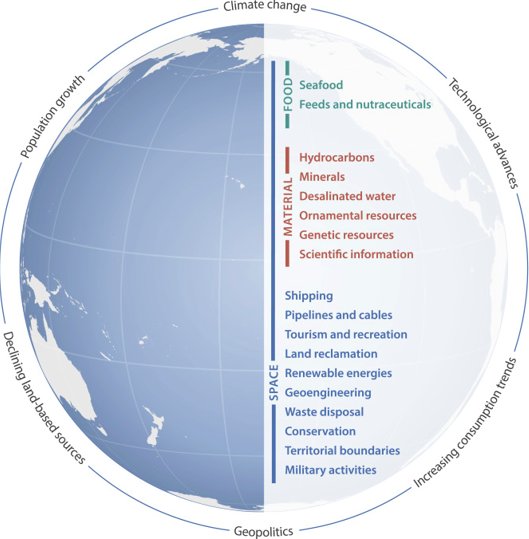
Food→
oceans and blue food have a role in food security
fishing fleets are going out further, deeper and for longer
are exploiting new products e.g. neutraceutical superfoods, mesopelagic fish- huge biomass
Materials→
OECD (Organisation for Economic Co-operation and Development) projects a nearly 2x increase in global materials use, many are sourced from the ocean e.g. sand and gravel which will see the largest growth
material extraction in 2011 and projected use in 2060:
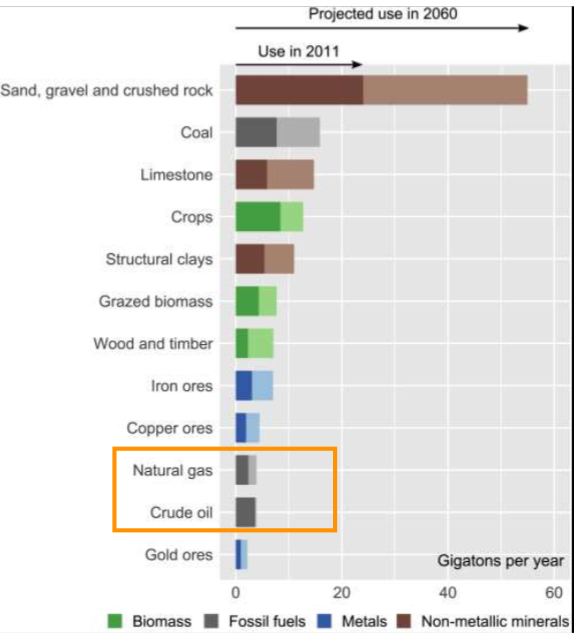
fossil fuels will still be a significant contributor of materials from the sea in the future: (yellow box)
still see evidence of this e.g. offshore oil platform in the gulf of mexico
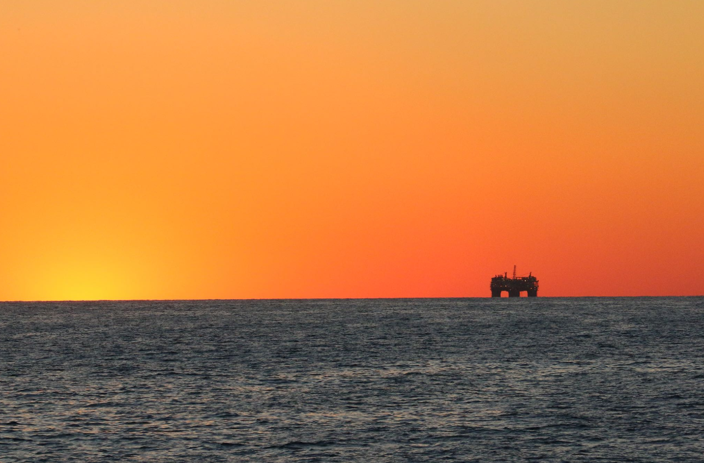
oil and gas still accounts for 1/3 of the whole ocean economy, even when we are transitioning to alternatives
most major new discoveries of hydrocarbon (new reserves of oil/gas) deposits are found offshore
exploiting new technology and is getting harder to source on land→ are moving into deeper waters
other potential resources→ gas hydrates (mainly methane) are present on the sea floor, 2x more than all fossil fuels source of carbon
potential locations of tests performed on gas hydrate resources- are all around the world:
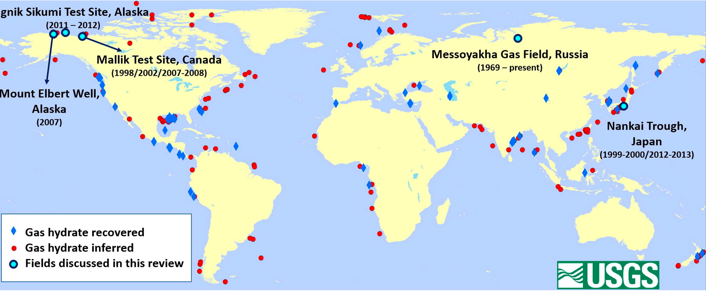
taking natural gas hydrates out of the sea, putting into a power plant- goes back into the deep sea, get clean energy:
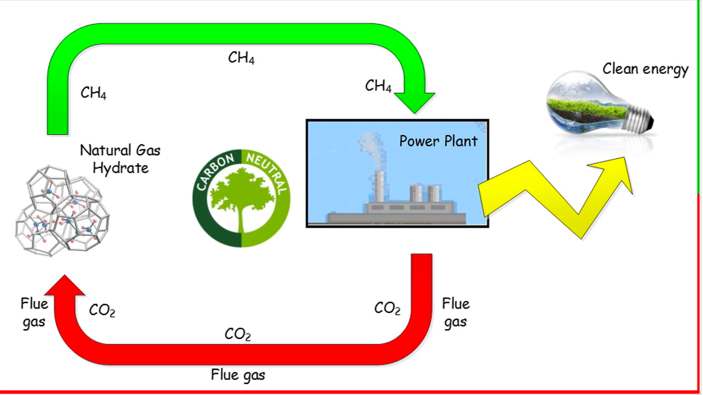
spreading of mining in the deep sea
targets high-value metals/minerals e.g. polymetallic sulfides/nodules which have large amounts of cobalt, nickel, manganese, lithium, copper→ used for green technologies (ironic)
current mining on land also has negative consequences→ there will always be a cost
countries with exploration contracts from the international seabed authority (deals with leases on the international seabed)→ many countries have claims all around the world:
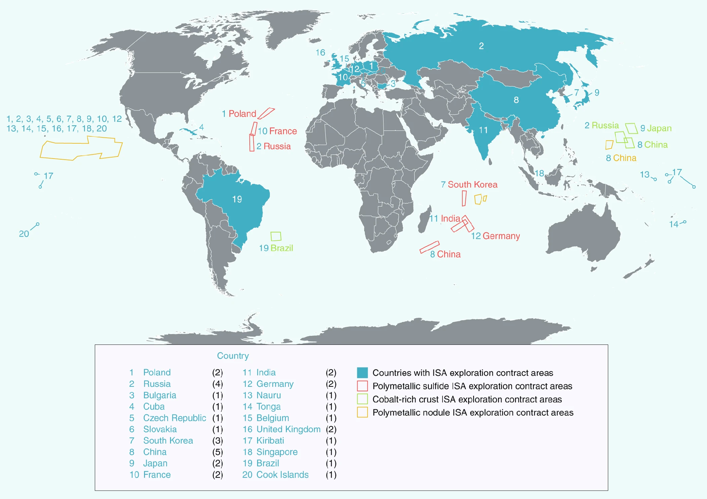
Space→
to exploit food and material, make a claim on space
other space claims include:
energy infrastructure
communications infrastructure (deep sea cables)
shipping (global trade)
conservation (MPAs- drive for 30% of ocean set aside for conservation by 2030)
irish sea→ lots of spatial claims of different activities, can end up with spatial/coastal squeeze where everyone has a reasonable claim on space and wants to use it
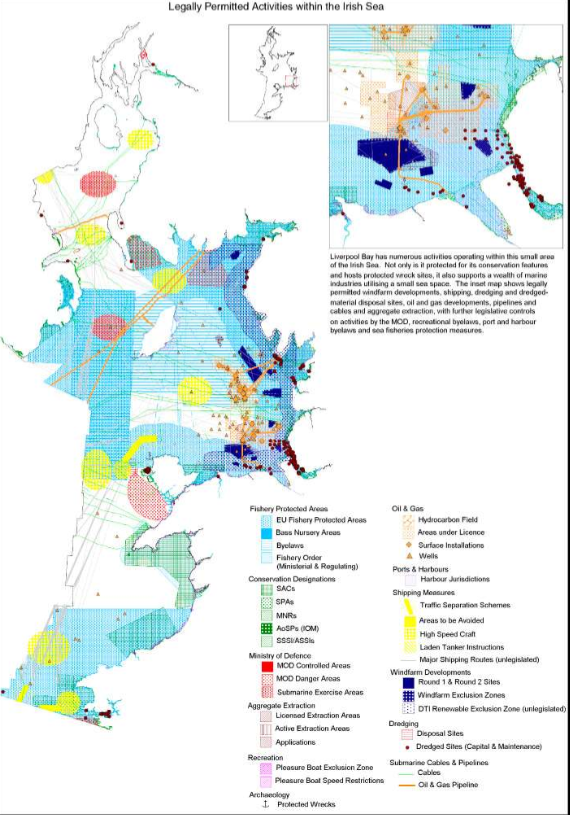
The blue acceleration-
The great acceleration→ expansion of human activities mainly since WW2
human impacts in the ocean was slightly later but mirrors trends on land→ termed as the Blue Acceleration
uptick of all activities/claims for food, materials, space:
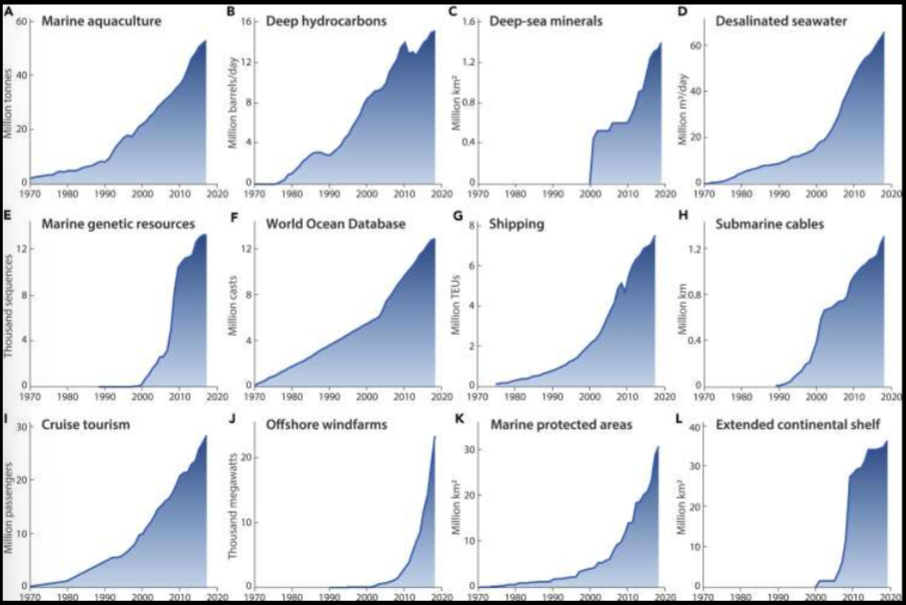
sharpest acceleration since the start of the 21st century
claims can overlap
→ the Blue Acceleration has increased pressures on the marine ecosystem, pushing the Earth system to its limits
e.g. an initiative to visualise the impacts→ Global Fishing Watch pull together large amounts of data, different human activities on the North Sea:
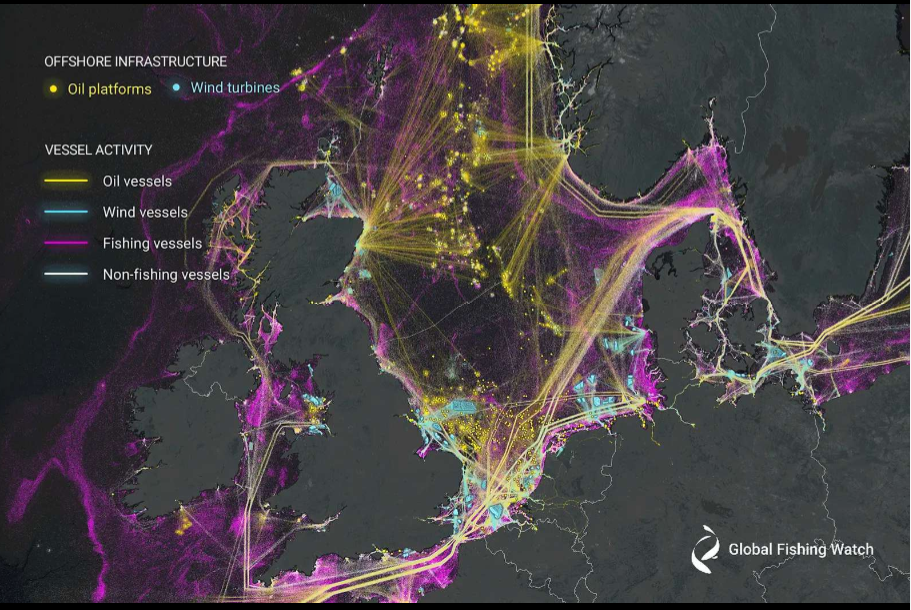
→ maps show how busy the seas are
Blue planetary boundaries-
planetary boundaries:
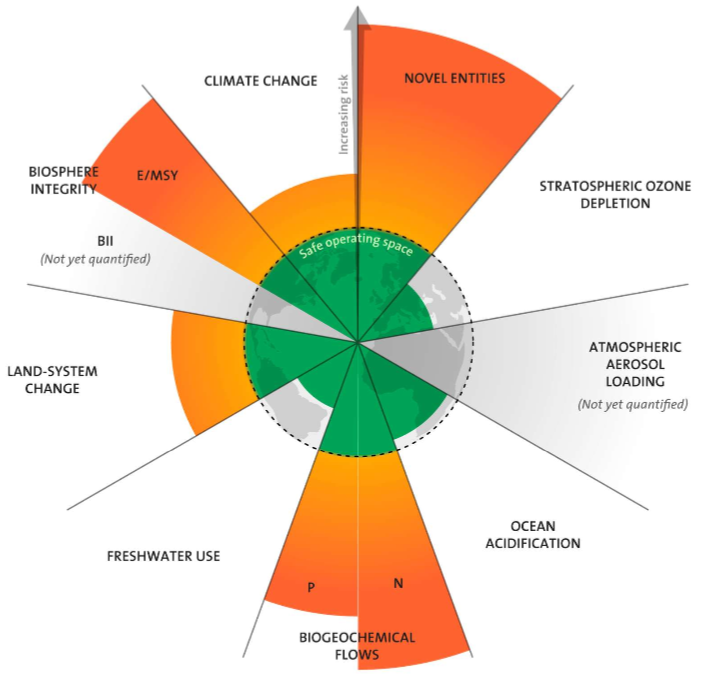
putting boundaries in spatial context:

BUT we live on a blue planet→ 70% of world surface is sea, 99% of habitable volume is marine, need to consider marine regions in planetary boundaries
paper kickstarted this thinking

integrating marine world into existing planetary boundaries:
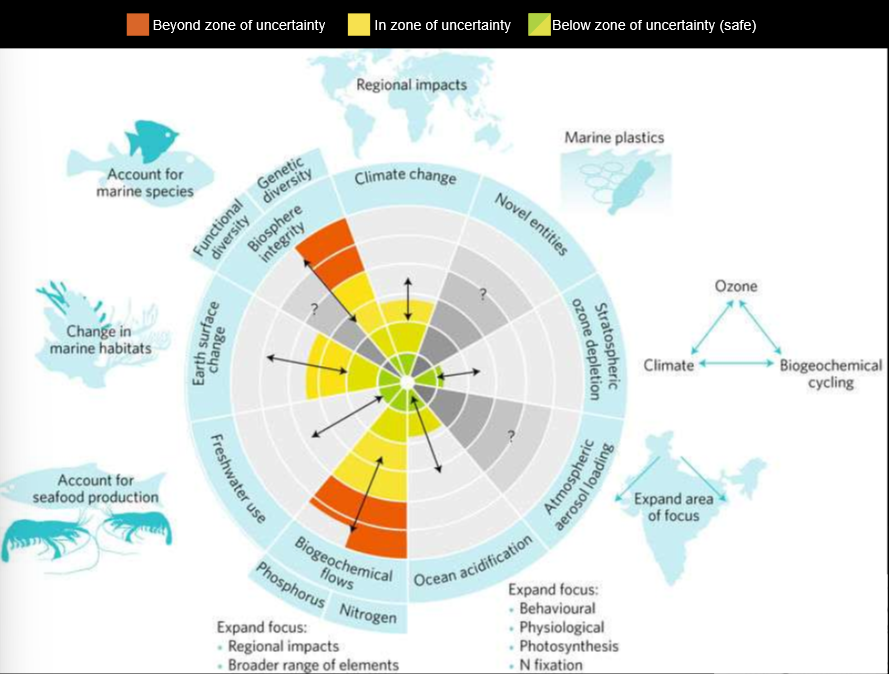
ways to map marine onto planetary boundaries→ land system changes:
coastal marine habitats can have large carbon sequestration (salt marshes can sequestrate 50x > tropical forests)
degradation of mangroves, seagrasses and coastal marshes can drive emissions of similar order to deforestation, despite covering 7x less area
albedo→
more ice- reflects solar radiation back into space, more sea- absorbs solar radiation
difference in albedo between boreal forest (low) and grassland (high) is similar to the difference between sea ice (high) and open ocean (low)

→ marine habitat change can impact global systems and should be included in this boundary
ways to map marine onto planetary boundaries→ biosphere integrity:
persistence- evolutionary history of biosphere
functioning- measures of functional diversity of those living there
Biosphere Intactness Index→ measure biosphere integrity at the global scale:
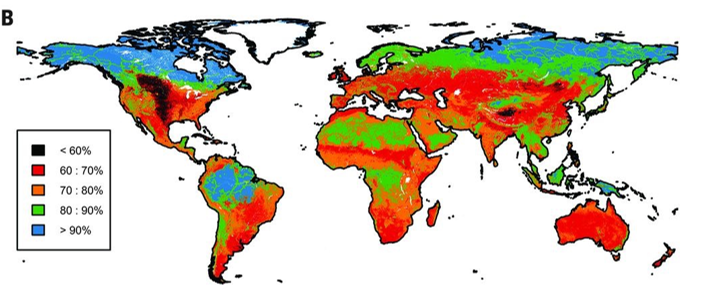
→ doesn’t include marine organisms at all
BII compares conditions to controls- compares what should be there to what is there now→ is more challenging to decide controls for marine
BUT there are well established measures of functional diversity using functional traits, size-based indicators e.g. large fish indicator- proportion of fish over a certain size in an ecosystem
→ trait-based measures can be used to integrate marine into the current biosphere integrity measures
ways to map marine onto planetary boundaries→ human appropriation of net primary productivity:
looks at how much of the NPP is used by people (directly or in our crops/livestock)
quantified HANPP on the global scale:
appropriating nearly all NPP in some parts of the world, all on a terrestrial level though
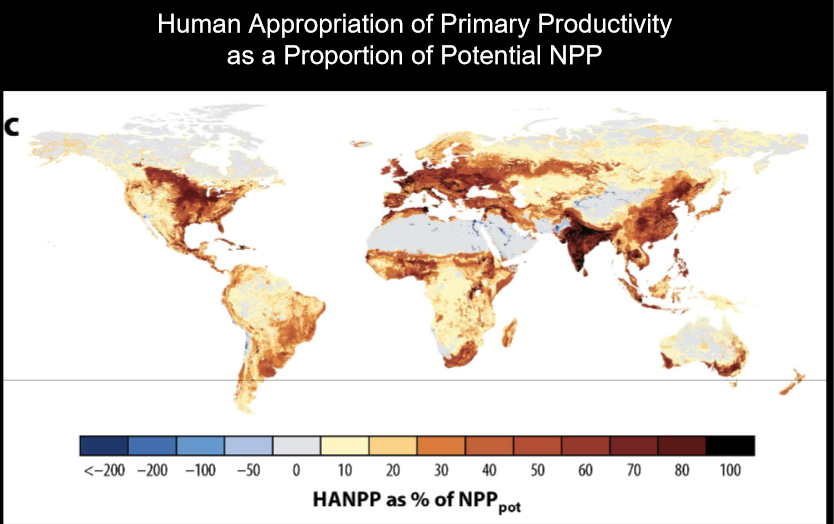
marine ecosystems are responsible for 50% of global primary productivity
similar proportions of NPP flow into fisheries in shelf seas as is appropriated by humans on land (food chains)
the oceans are comparable to land as a carbon sink→ important to understand how much we take out, how much we put in
attempt to integrate marine→
large parts aren’t appropriated but around coastal areas are very high, similar to land:
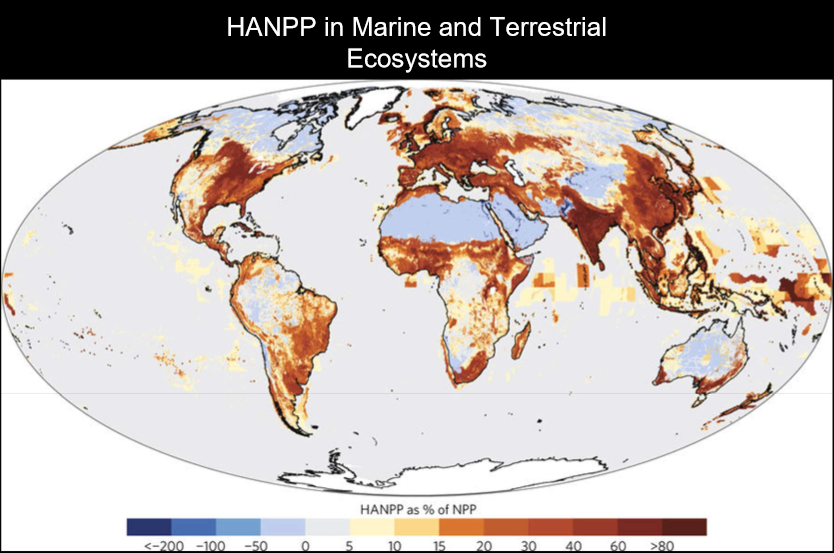
→ are initial attempts to incorporate marine systems into the planetary boundaries concept
future→
planetary boundaries need to recognise the blue ecosystems
need to include the oceans in any kind of global effort
Equitability and the global commons-
costs and benefits of the blue acceleration are not equitably distributed because:
some countries are landlocked, some are very coastal, countries have different capacities to benefit from marine resources
benefits mainly to economically powerful states/corporations
costs mainly to developing nations or small island developing states
conservation overlooks these social and equity issues e.g. 30 by 30
each country has terrestrial waters (extend 12nm offshore), exclusive economic zones (200 nm offshore) and the rights to exploit these waters
areas beyond national jurisdiction→ is everyones
Seabed Grabbing-
national claims to ocean space→ map shows EEZs (200nm off shore) and extended claims (UNCLOS allows countries to make an extended claim to edge of continental shelf), blue- ABNJ:
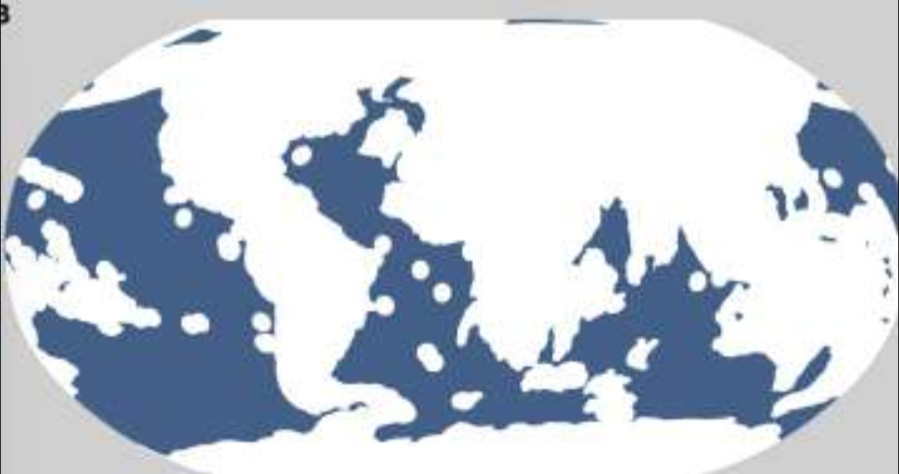
some countries have done well with their claims:
most winners are islands and overseas territories
e.g. small island developing states are becoming large ocean states- the Cook Islands has claimed an area of extended continental shelf equivalent to 1,700 times its land surface
e.g. australia secured >2.5M km2 of additional seabed thanks to their claims on 2 uninhabited islands: Heard Island (368 km2) and the McDonald Islands (2.5 km2)
some countries are losing with their claims:
countries with limited or no coastline
aus has claims on both uninhabited islands, extended it
UK’s total EEZ→ have big areas from remaining UK overseas territories, legacies of the colonial H:
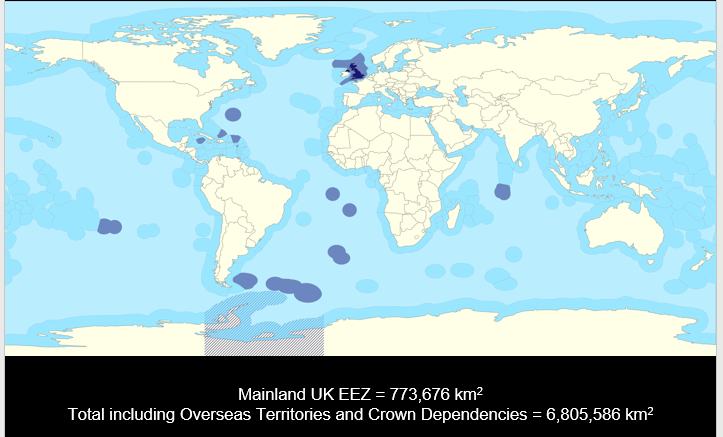
transnational corporations→
drive most commercial activity in the oceans
revenue is concentrated in a few, large TNCs e.g. the Ocean 100 companies (100 largest ocean companies) generated 60% of total revenues by ocean industries in 2018
are not distributed equally around the world e.g. US (12%), Saudi Arabia and China (8%), Norway (7%)
looking at the various ocean industries and asking what proportion of the industry is controlled by the 10 biggest companies in that industry→ usually control a lot, is not universal e.g. lots of small scale fisheries in seafood
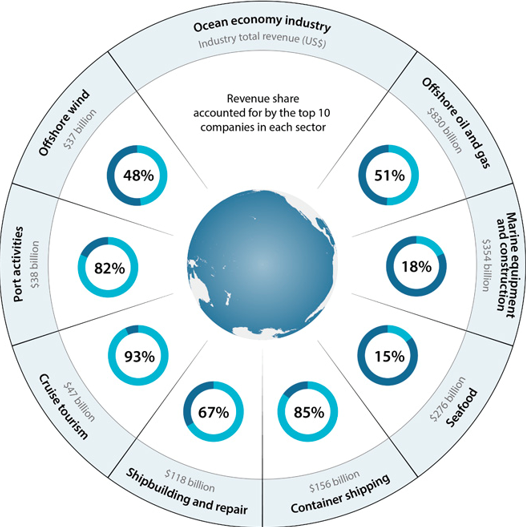
→ big companies are actively important in the seas
Having global stewardship-
is difficult:
international bodies have struggled to balance conservation and sustainable use
SDG14: Life Below Water is systematically the least prioritised
2/3 of the ocean is ABNJ→ governance is fragmented and ineffective
paper- makes the case for the high seas as a global commons:

ABNJ can be considered a ‘final frontier’ → are distant and vast
The UN treaty on biological diversity found in areas beyond national jurisdiction (BBNJ) was recently agreed (see https://www.un.org/bbnj/)
is needed as the Blue Acceleration is expanding into ABNJ
Question paper ask→ will economic and social benefits from ABNJ drive progress towards achieving SDGs, or further cement global inequities?
solution→ decide as a society that equity will be a guiding principle:
activities in the ABNJ currently are focused only on production→ those accessing it have the financial and human capacity needed to operate there
instead should have common scientific endeavours e.g. a deep sea equivalent to the International Space Station
making the global commons as a conservation area by default→ has more benefits than costs:
climate change mitigation and adaptation
spillovers of fisheries in national waters
increasing nutrition and food security in developing countries
can implement these before significant exploitation (deep sea mining/mesopelagic fishing) begins
→ there are high level panels that are looking at recognising the rights of nature, which could transform the relationship between us and the oceans